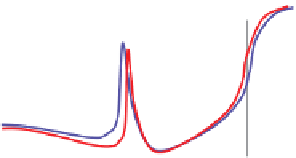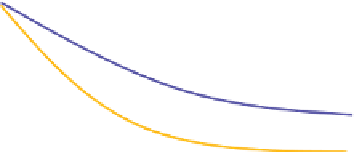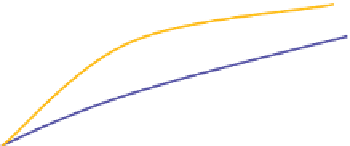Geology Reference
In-Depth Information
b)
a)
1.0
0.75
0.8
0.6
0.50
0.25
0.4
0.00
0.2
-0.25
0
- 0.2
-0.50
Shale on 20% porosity dolomite
-0.75
-0.75
- 0.4
0
10
20
30 40
50
60
70
80
90
-0.50
-0.25
0.00
0.25
0.50
0.75
Angle of incidence
Intercept
Figure 5.16
Simple AVO model of shale overlying dolomite with 20% porosity: (a) AVO plot, (b) AVO crossplot showing the AVO response for
pre-critical angles.
b)
a)
stiff
AI
PR
soft
Porosity
Porosity
Figure 5.17
Relative stiffness and its effect on acoustic impedance and Poisson's ratio.
5.3.4 The effects of rock fabric
and pore geometry
Rock fabric and pore geometries are important
factors in the stiffness (and velocity) of all rocks.
Stiffness has a key influence on the rock frame,
critical in determining the velocity and magnitude
of fluid effects on compressional velocity (
Chapter
8
). The concept is straightforward, with
than for the 18% porosity chalk case. Importantly,
these observations indicate that the fluid effect is
not simply related to porosity, it is also related to a
combination of the mineral composition and the
stiffness of the rock frame. Another observation
from these carbonate models is how the critical
angle is often within the acquired angle range of
seismic data and that the critical angle changes with
fluid fill and porosity. Mapping the onset of critical
angle energy in carbonate environments may pro-
vide a useful seismic attribute for lithology or fluid
interpretation.
rocks
tending to give low acoustic impedance and high
Poisson
'
soft
'
rocks give high acoustic
impedance and low Poisson
'
s ratio whilst
'
stiff
'
69
'
s
ratio (
Fig. 5.17
).




































































